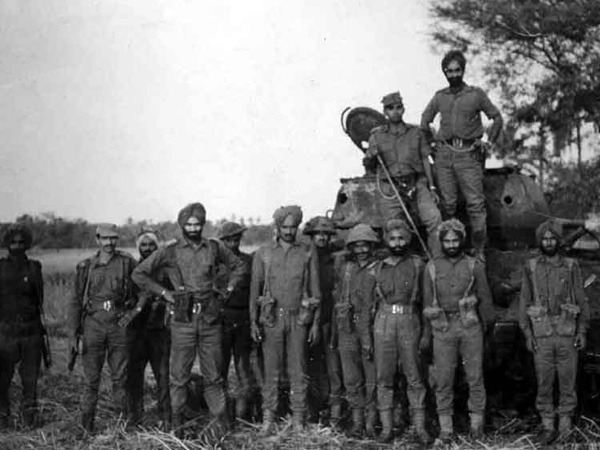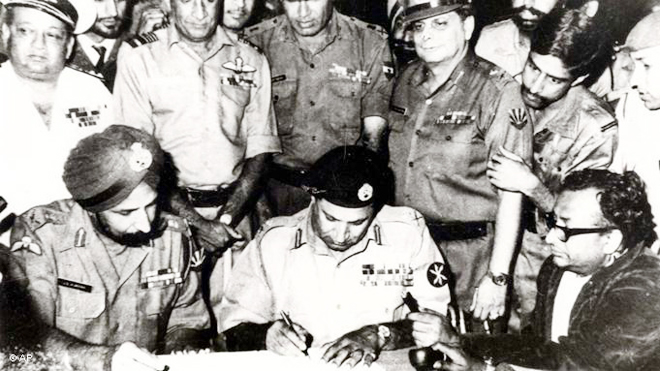Vijay Diwas: When India won and Bangladesh got liberated
The Indo-Pakistan War of 1971 is heralded as one of the most convincing victories of the annals of the military history. It culminated with the abject surrender of Pakistani forces in East Pakistan (now, Bangladesh), with almost 1,00,000 being taken PoWs, and eventually leading up to the liberation of Bangladesh on December 16.

New Delhi: The Indo-Pakistan War of 1971 is heralded as one of the most convincing victories of the annals of the military history. It culminated with the abject surrender of Pakistani forces in East Pakistan (now, Bangladesh), with almost 1,00,000 being taken prisoners of war (PoWs), and eventually leading up to the liberation of Bangladesh on December 16.
On the occasion of #VijayDiwas , Smt @nsitharaman pays homage to the brave martyrs who lead India to victory in the war of 1971. She places a floral wreath at the Amar Jawan Jyoti at India Gate. Jai Hind! pic.twitter.com/HPvF399hHm
— Raksha Mantri (@DefenceMinIndia) December 16, 2017
India and Bangladesh, since then, celebrate Vijay Diwas, also known as Victory day, every year to mark both the countries' military victory over Pakistan.
As Lt. Gen. PS Mehta puts it, "The Indian Defence Forces celebrate Vijay Diwas on December 16 to remember the day of the 1971 war between India and Pakistan. On December 3, Pakistan attacked 11 of the Indian air fields because of which the war actually started. In response, India did take offensive undertaking in Eastern and Western areas of Pakistan. This Vijay Diwas is celebrated because in just 13 days, Indian forces, which included the Air Force, Para Troopers, Ground Force and Navy, made Dhaka independent."
Also Read: Security forces gun down Naxal in Odisha
Also Read |
Cancer of terrorism now consuming Pak's body politic, says EAM Jaishankar
"After this day, the birth of a new nation took place, which is now known as Bangladesh. This was the first time, in the 21st century, where India showed the whole world that it liberated a new country. Maybe this was the first after second world war that a new country was born out of a war. All the army, all the commands that took part in that war, the veterans, who took part in this war, are also called in to join the celebration," he adds.
Gen. Mehta further says the battle also reminds him they made General AA Khan Niyezi and 90,000 'Prisoners of War' surrender in Bangladesh."This is believed to be one of the most historic events in the military history. But this occasion will be special this time, as some veterans and serving soldiers from Bangladesh army would also come in the Eastern command in Fort William, Kolkata and grace the occasion with their presence," he adds.
Another veteran and defence and security expert says, "The war was a result of genocide by the Pakistani Army in erstwhile East Pakistan which led to the influx of lakhs of refugees into India and creation of a humanitarian crisis. Indira Gandhi, then Prime Minister of India, made many attempts to galvanise international action against Pakistan and support to India to look after the refugees, but it did not come by."

"Pakistan leveraged India's justified support to the freedom fighters of East Pakistan as an excuse to declare war against India. On December 3, 1971, at 5.45 pm, Pakistan launched a pre-emptive airstrike at Indian airfields of Srinagar, Avantipur, Pathankot, Uttarlai, Jodhpur, Ambala and Agra. The first salvo was followed by another one before India launched its response. While the Pakistani pre-emptive strikes could not cause any damage to the Indian aircraft or airfields the Indian Air force, in a short span of time established complete air superiority over East Pakistan while dominating the skies on the western front too by flying an unprecedented 500 plus sorties a day," he adds.
Also Read | Asia Cup: World Cup combination, renewal of Indo-Pak rivalry
On ground, the Indian forces in East Pakistan relentlessly marched forward despite the enemy strength of about four divisions and established complete supremacy which ultimately led to the Pakistani forces laying down their arms. The surrender by the Pakistan Army Commander Lt Gen AAK Niazi was accepted by the Army Commander of eastern Command Lt. Gen. JS Arora.
Also Read: Deadline for linking of Aadhaar with various services extended
Pakistan's combat strength in East Pakistan by the end of November 1971 was four divisions. In addition, there were 25,000 irregulars, one regiment plus a squadron of Chaffee tanks, an ad hoc squadron of Chaffee and PT 76 tanks. Its Air Force had 25 Sabre jets and a few helicopters. The Pakistan Navy had sufficient gunboats operating in inland and coastal waters. However, not a single aircraft was destroyed on ground. The Indian Air Force went into action the same night and continued operations at an unprecedented pace of 500 sorties per day, a rate higher than in the Second World War.
In the eastern sector, Indian Air Force Hunters, SU-7 and Mig-21s dive bombed the two PAF airfields, disabling them for flights, and decimated its aircraft. IAF executed more than 4,000 sorties to attain the vital air superiority over East Pakistan, and to support the Indian Army's ground operations. Pakistan attacked all along the western front, heavy offensives were was witnessed in Poonch, Chhamb and the Shakarhgarh Bulge, but they did not succeed due to the courage and tenacity of the Indian forces," he added.
Pakistan then strategised annexing of some territories in the deserts as that could play out as assets on the negotiating table. This led to the epic Battle of Longewala where an Infantry company of 23 Punjab under Major (later Brigadier) KS Chandpuri withstood an assault by hundreds of tanks throughout the night. The Pakistan Tanks were decimated the next morning by the Indian Air Force, the defence expert concludes. (ANI)
 Dynamite News
Dynamite News 